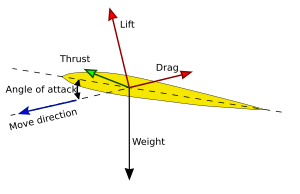Lift (force) facts for kids
Lift is a powerful force that pushes things up or sideways. It usually works against the pull of gravity or the direction of air or water flow. It's what helps airplanes fly, helicopters hover, and sailboats glide across the water.
What is Lift?
Lift is one of the four main forces that act on an aircraft, along with weight, thrust, and drag. Think of it as the upward push that lets a plane leave the ground. But lift isn't just about going up! It can also push things sideways, like a sail on a boat. It can even push things downwards, like the special wing on a race car that helps it stick to the track.
How Does Lift Work?
The simplest way to understand lift, especially for an airplane wing, is to think about how it pushes air. When a wing moves through the air, its shape causes the air to be pushed downwards. According to Newton's Third Law (which says that for every action, there's an equal and opposite reaction), if the wing pushes the air down, the air pushes the wing up. This upward push is the lift force.
Where Do We See Lift?
You can find lift in many places, not just on airplanes!
- Aircraft: The wings of airplanes create lift to fly.
- Helicopters: Their spinning rotors act like wings to lift them into the air.
- Boats: Propellers on boats use lift to push water backward, moving the boat forward.
- Sailboats: Sails use the wind to create lift, pushing the boat sideways through the water.
- Wind Turbines: The blades of a wind turbine are shaped like wings. The wind creates lift on these blades, making them spin and generate electricity.
- Fans: The blades of a fan create lift to push air around a room.
Images for kids
-
Flow around an airfoil: the dots move with the flow. The black dots are on time slices, which split into two – an upper and lower part – at the leading edge. A marked speed difference between the upper-and lower-surface streamlines is shown most clearly in the image animation, with the upper markers arriving at the trailing edge long before the lower ones. Colors of the dots indicate streamlines.
-
Control volumes of different shapes that have been used in analyzing the momentum balance in the 2D flow around a lifting airfoil. The airfoil is assumed to exert a downward force −L' per unit span on the air, and the proportions in which that force is manifested as momentum fluxes and pressure differences at the outer boundary are indicated for each different shape of control volume.
See also
 In Spanish: Sustentación para niños
In Spanish: Sustentación para niños












